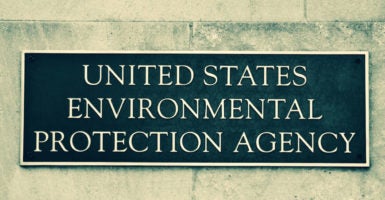Oklahoma Attorney General Scott Pruitt’s confirmation hearing to head up the Environmental Protection Agency provided a glimpse into how the agency would operate under new leadership.
Critical reforms should rein in regulations that have little scientific backing and environmental benefit. A top priority for the EPA and the new administration should be eliminating the use of the social cost of greenhouse gas emissions.
Over the last eight years, the Obama administration has relied on a metric known as the social cost of carbon to justify many of its global warming regulations. In addition, the administration recently began to consider similar metrics regarding methane and nitrous oxide emissions.
Here’s how it works.
The social cost of carbon is a monetary value measuring the alleged climate change damages from each ton of emitted carbon dioxide into the atmosphere. The EPA also assigns monetary values to other greenhouse gases such as methane and nitrous oxide.
In this framework, adding the alleged benefits of abated carbon dioxide, methane, or nitrous oxide emissions increases the benefits in the agency’s cost-benefit analyses.
As a result, the EPA and other agencies exaggerate the benefits of global warming regulations or deciding on whether or not to build energy projects, whether it is the Keystone XL pipeline or a coal export terminal.
The social cost has nothing to do with spewing pollutants into the atmosphere that are potentially hazardous to public health, but instead has everything to do with politicizing man-made global warming.
At The Heritage Foundation, we have found that these models measuring the social cost of carbon, social cost of methane, and social cost of nitrous oxide might be interesting academic exercises—but they are nowhere near reliable enough to be useful for devising energy and environmental policy.
The social cost of carbon, social cost of methane, and social cost of nitrous oxide are based on three statistical models.
At Heritage, we rigorously looked at two of these models and found that they use outdated assumptions regarding climate sensitivity, ignore the Office of Management and Budget’s recommendations regarding discount rates, and are based on economic forecasts 300 years into the future.
Upon making very reasonable changes to these assumptions, we found that the estimates of the social cost of carbon, and more recently the social cost of methane and social cost of nitrous oxide, drop considerably (in some cases by 60-90 percent).
In fact, under some very reasonable assumptions, the social cost of carbon can even be negative, suggesting some benefits of carbon dioxide emissions.
Moreover, at Heritage we found that if the EPA and other agencies continue to use these models and cost estimates to justify their regulations, it would impose devastating effects on the economy.

The Paris Agreement is one example of the damaging regulations that result from current EPA models.
Ordinary families would suffer as electricity prices would increase all across the country, disproportionately impacting lower-income households. Economic prosperity would decline, as would job opportunities.
Importantly, these regulations would have little to no climate benefit. Our research has also consistently found that reducing the emissions of these greenhouse gases would have a negligible effect on global temperatures and sea level rise.
The Trump administration should ban the use of these integrated assessment models and the social cost of greenhouse gases for EPA regulations and policymaking.
Enabling markets and entrepreneurs to meet America’s energy demands, not the whims of bureaucrats in Washington, D.C., will be one of the first steps toward making American energy even better.






























